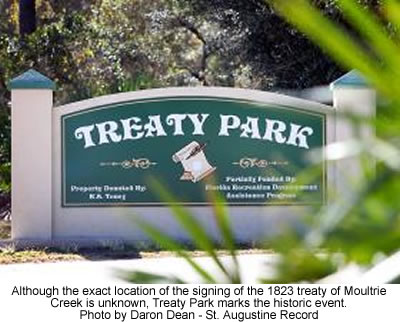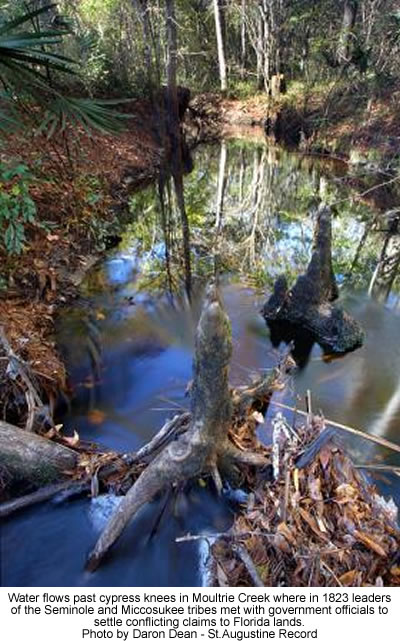 |
Canku Ota
|
 |
|
(Many Paths)
|
||
|
An Online Newsletter
Celebrating Native America
|
||
|
February 1, 2010 - Volume
8 Number 2
|
||
|
|
||
|
How The 'Treaty'
Of Treaty Park Was Broken
Immigration Led To Failure That Sparked Seminole War |
||
|
by Kati Bexley - The
St. Augusting (FL) Record
|
||
 Treaty
Park is a popular spot in St. Johns County for soccer players, dog
walkers and skate boarders. Treaty
Park is a popular spot in St. Johns County for soccer players, dog
walkers and skate boarders. But it also represents an 1800s treaty that was broken and led to the largest and most costly Indian war in the United States, said Bill Adams, historian and St. Augustine's former Heritage Tourism director. "This is a very significant treaty," Adams said. "This was the greatest of all Indian wars fought in American History." Robin Moore, county historic resources director, said the Treaty of Moultrie Creek was signed at a large Oak tree near the 47-acre complex Treaty Park. The treaty was signed on the north side of Moultrie Creek and the park is located on the south side (off Wildwood Drive), he said. Adams said the Treaty of Moultrie Creek brought together the U.S. government and 17 of the most diverse groups of Seminole Indians in 1823. About 425 Seminoles attended the meeting along, and 32 chiefs signed the document, said Adams in his book "St. Augustine and St. Johns County: A Historical Guide." The treaty established a 4-million-acre reservation for the Indians in central Florida, he said.
"It was a popular event," he said. "People made the day of it and traveled so they could see the signing." But the treaty failed to ease tensions between white settlers and the Seminole tribe, according to state historical documents. Adams said the intense disagreements led to the Second Seminole War in 1835, which was the largest and longest Indian conflict in U.S. history. It was a seven-year war that destroyed nearly every white settlement along Florida's east coast, south of St. Augustine, Moore said. "The Seminole wars played a major role in how Florida developed," Moore said. "Florida's economic development completely stopped. It halted American progress. Huge plantations in Florida were completely destroyed." Adams said one reason why the treaty was broken was because of the "enormous" amount of immigration from people in other states moving to Florida. Adams said the U.S. had acquired Florida in 1821. "Florida land was found to be very desirable," Adams said. "The U.S. government didn't anticipate so many people moving into Indian lands." Moore said there is a marker at Treaty Park with the Treaty of Moultrie Creek's history, and there is an historical marker at the actual site of the treaty signing. But Moore hopes to do more. "I would like to have an interactive historical exhibit at the park," he said. "It's a really important episode in U.S. history that was right here in our county." |
|
|
||
|
|
||
| Canku Ota is a free Newsletter celebrating Native America, its traditions and accomplishments . We do not provide subscriber or visitor names to anyone. Some articles presented in Canku Ota may contain copyright material. We have received appropriate permissions for republishing any articles. Material appearing here is distributed without profit or monetary gain to those who have expressed an interest. This is in accordance with Title 17 U.S.C. Section 107. | ||
|
Canku Ota is a copyright ©
2000, 2001, 2002, 2003, 2004, 2005, 2006, 2007, 2008, 2009, 2010
of Vicki Barry and Paul Barry.
|
||
 |
 |
|
|
The "Canku
Ota - A Newsletter Celebrating Native America" web site and
its design is the
|
||
|
Copyright ©
1999, 2000, 2001, 2002, 2003, 2004, 2005,
2006, 2007, 2008, 2009, 2010
of Paul C. Barry.
|
||
|
All Rights Reserved.
|
||
 Moore
said the site was likely chosen for the treaty signing because St.
Augustine was the center of civilization on the east coast at that
time. He said the signing was a nationally-known major event, and
many St. Augustine residents attended.
Moore
said the site was likely chosen for the treaty signing because St.
Augustine was the center of civilization on the east coast at that
time. He said the signing was a nationally-known major event, and
many St. Augustine residents attended.